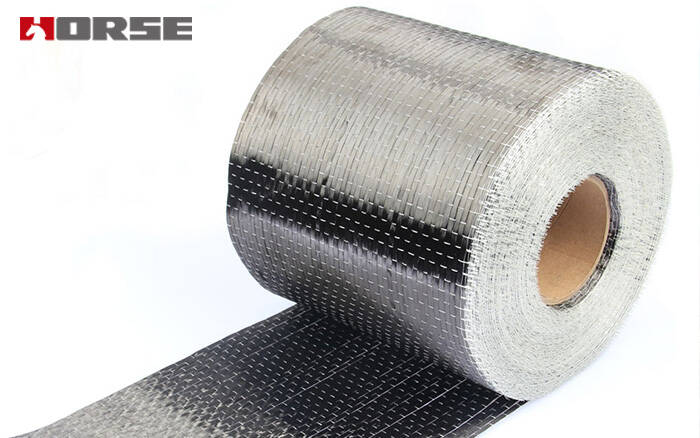Solutions
Horse Construction offers full range of structural strengthening materials with technical supports, documentation supports, products supports, project supports.
unidirectional carbon fiber fabric

Product Name: Horse Construction Unidirectional Carbon Fiber Fabric
Product Code:
| HM-20 | 200g/㎡ (5.84 oz./sq.yd.) |
| HM-23 | 230g/㎡ (6.72 oz./sq.yd.) |
| HM-30 | 300g/㎡ (8.76 oz./sq.yd.) |
| HM-45 | 450g/㎡ (13.14 oz./sq.yd.) |
| HM-53 | 530g/㎡ (15.48 oz./sq.yd.) |
| HM-60 | 600g/㎡ (17.52 oz./sq.yd.) |
Product Description
Horse CFRP fabric is a high strength unidirectional carbon fiber fabric pre-saturated to form a carbon fiber reinforced polymer (CFRP) fabric used to strengthen structural concrete elements.
Where to use:
| Load Increase | Seismic reinforcement | Structural damage | Structural changes | Design or construction defects |
• Increased loading • Install heavy machinery in industrial buildings • Vibration structure • Changes in building utilization • Meet the changed standards or specifications | •Column packing •Masonry wall | •Aging of building materials • Vehicle crash •Fire and explosion •Prevent defects caused by earthquakes | •Remove walls or columns • Remove the flat part of the opening | • Insufficient reinforcement • Insufficient structural depth |
Carbon FIber Strengthening Advantage
• Easy installation
• Corrosion resistance
• Short construction period
• No maintenance required
• Light weight, no influence to original structure
• Low cost, cost effective compared with other methods
Product Data Sheet
| Dry Fiber Typical Properties | |
| Standrad Value of Tensile Strength | 4900MPa |
| Tensile Elastic Modulus | 234500MPa |
| Elongation | 1.7% |
| Laminate Fiber Typical Properties | ||
| Standrad Value of Tensile Strength | 3800MPa | |
| Tensile Elastic Modulus | 234500MPa | |
| Elongation | 1.7% | |
| With Concrete | Concrete Damaged: ≥2.5MPa | |
| Densiy | 1.8g/cc(0.065lbs.in3) | |
How to Use
>>The treatment of concrete surface
The cosmetic layer, oil, dirt etc. Of concrete surface should be chiseled off and then rubbed off 1 ~2 mm thick surface layer with the
angle grinder, concrete components should be handled by chamfering on the corner, dust was blew out with compressed air after the
completion Of polishing, and finally the surface was wiped by cotton cloth dipped in acetone, and kept dry for use. If the concrete
needed to strengthen existed cracks, first choose HM-120M perfusion adhesive or HM-120L pouring crack adhesive to perfuse according
to the size of crack, and then strengthen.
>>Primer construction
When construction, two components of HM-180 primer were weighed according to the stipulated proportion of preparing glue, and
dumped into a clean container and stirred to uniformity (when mixing, best mix along the same direction to avoid the air from forming
air bubbles.) Brush or roller brush was used to evenly brush on the concrete surface, after the glue surface layer dried, it should be
brushed several times depending on the particular circumstances, but the coating thickness did not exceed 0.4 mm, and it should
not be missed out to brush, or have flowing or bubbles, waiting for glue curing (curing time was depended on the site temperature,
it was appropriate when finger felt dry, generally not less than 2 hours), then the next process was proceeded. The glue prepared
every time should be used up one time during the applicable period of the glue.
>>Leveling construction
The pores and defects on concrete surface were filled by HM-180CE leveling adhesive.When depression area was existed, the prepared leveling
adhesive was used to repair and fill through scraper embedding and scraping, the position emerging altitude difference such as the
joint of templates should be filled by leveling adhesive, which tried to minimize the height difference. The treatment of corner was that
it was repaired to smooth arc through leveling adhesive, its radius was not more than 20mm. After the leveling adhesive cured (curing
time was depended on the site temperature, it was appropriate when finger felt dry, generally not less than 2 hours), the next process
should be proceeded further.
>>Paste of unidirectional carbon fiber fabric
HM-180C3P carbon fiber impregnated adhesive was smeared to the pasted area evenly,the corner site was more smeared appropriately. Paste after
hauling unidirectional carbon fiber fabric tight and alignment, use a plastic scraper or roller (a paint roller that the villus was removed outside) to roll
repeatedly along the same direction, until the glue compound exuded. And then smear impregnated adhesive to the outside surface
of the carbon fiber fabric evenly, and roll repeatedly that the impregnated adhesive can immerse the carbon fiber fabric in two ways,
if it is multi-paste, until your fingers touch dry, the next layer of paste can be beginner. If the carbon fiber fabric needs overlapping
>>Curing and conservation
Prevent rain or moisture 24 hours after the completion of construction, and pay attention to protection against a hard Object bumping
into the surface of the construction. When the average air temperature is 20 , 25 ℃ , the curing time is not less than 3 days; when
the average air temperature is 10 ℃, the curing time is not less than 7 days.
Tools
You can use scissors to cut the fabric to an appropriate length. Since blunt or worn cutting tools can damage, weaken or wear fabrics, they should be avoided.
You can find anything here you are in need of, have a trust trying on these products, you will find the big difference after that.

High strength carbon fiber reinforced polymer (CFRP) strip / laminate / plate for structural strengthening and concrete repair

High strength, unidirectional carbon fiber fabric pre-saturated to form a carbon fiber reinforced polymer (CFRP) fabric used to strengthen structural concrete elements.

High strength, unidirectional carbon fiber sheet pre-saturated to form a carbon fiber reinforced polymer (CFRP) sheet used to strengthen structural concrete elements.